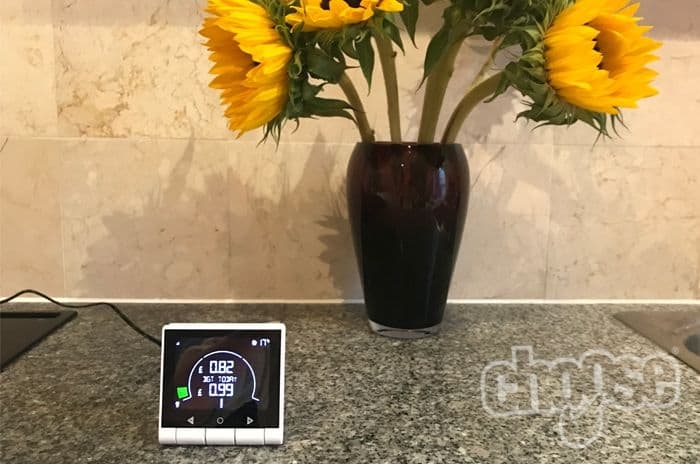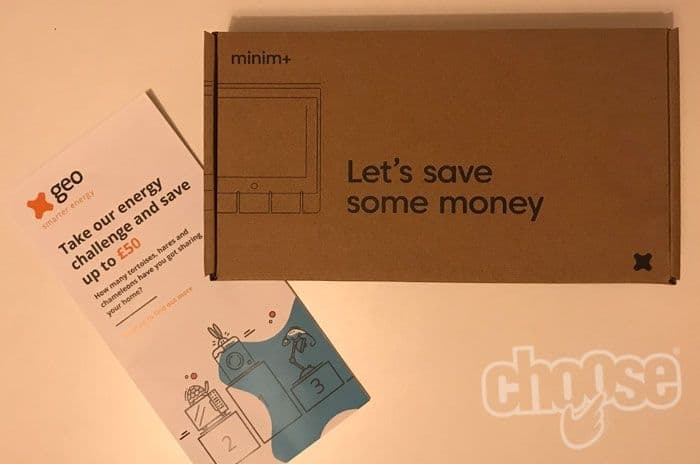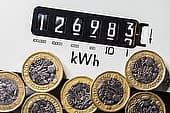In this hands-on review, we test out this energy monitor and reveal how easy it is to use and whether using an energy monitor like this, really can save money.

| Geo Minim | |
|---|---|
| Cost | £37.95 |
| Functions | Budgeting, CO2 calculations, wattage, temperature |
| Real time monitoring | Yes |
| Installation | DIY |
| Connectivity | No Wi-Fi required |
| Historical tracking | Up to two months |
| Monitoring | Using display unit |
| Where to buy | Buy now |
The geo Minim+ costs £37.95, and they challenge new purchasers to save up to £50 a year by using the device to monitor energy and cut usage by changing habits.
So how many tortoises, hares and chameleons do we have in our house? Let's find out.

The geo Minim+ challenges purchasers to save up to £50 a year.
Set up
The geo Minim+ is fairly easy to set up.
We had a single-phase energy meter which meant we had to place one clip around our live - mains in - wire, and then attach this to the battery powered transmitter.
If you have two red wires, the live mains-in wire is usually the first going into the meter on the left-hand side.
The clip was fairly easy to add except we did need to squeeze it in due to not having masses of space between our cable and the wall. Our meter was mounted almost behind a dry-wall though, so it's unlikely everyone will have this problem.
Once the clip and transmitter is attached to the meter, you then attach the relevant plug to the USB cable and plug this into the monitor, choosing a suitable power socket where you want to display the device.
Once on, the monitor itself steps through basic set-up for date and time, and then has a simple menu in order to set up your electricity tariff charges.
You can add up to three tariffs, and a standing daily charge. You'll need to access your electricity prices from a recent bill - and look for the price per Kwh and the standing charge - both units will be in pence, so add a 0 when converting to the pound units of the monitor.
We're paying 14.51 pence, so we entered £0.145 into the monitor, and our standing charge is 24.67 pence so we entered £0.246.
The monitor paired itself automatically to the transmitter and we had no issues with connectivity, even when using the device upstairs to our energy meter.
Monitor information
Once set up and ready to go, the monitor provides information including how much has been spent so far that day, current usage in pounds and pence and current usage in watts.
The watts data allows you to see more accurately how much electricity is being used at any one time, for example when you boil the kettle.
The currency usage and total for the day is a really useful way of seeing how much you're spending against a set budget - which is calculated based on the monthly amount entered - which as we put in, can be your direct debit for the month.
While the information is certainly adequate, it is simple, and isn't as useful as a more feature-rich app could be. For example, the energy monitor is very much like a simple thermostat - you can see what you're using at the time, but it doesn't automatically record or plot usage over time or provide a history of use.
You can however see what you're using and spending in real time - and that provides a very real incentive to reduce use - which is, after all, the purpose of the device.
Energy savings
As someone who is already fairly careful with electricity use I wasn't sure how much I was going to be able to save, and almost immediately felt I may have to sit in a cold dark room for entertainment in order to cut back further.
With my fridge/freezer still running, I already had a background load of just 65W.
That said, with the energy monitor within sight of the kettle, and noticeably costing me 50p per kWh, my tea-making use was halved; I already felt prompted to make my second cup of tea with the previously-boiled water instead of re-heating it.
Money saved: check.
Geo, the device makers, suggest starting your energy saving adventure by turning everything off, turn back on only what you need, and work out your background load.
Once this is done you can start working out what different appliances in your home use and how often you're using them, then start reducing that.
In addition, you can also check the cost of lights and look to save money by changing out energy saving bulbs, or getting into a better habit of turning off lights you're not using.
So to calculate how much different usage costs, and what we can save, we can use the following calculations:
- Watts x hours used = Watt hours
- Watt hours / 1000 = kWh per day
- kWh per day x 30 days = kWh per month
- kWh per month x pence per kWh = Cost per month
Looks simple enough!
The costs below are based on the energy tariff at the home the monitor was tested - 14.51 pence per kWh - costs will vary depending on the energy tariff for a particular household.
Note also, that in addition to these costs, electricity providers charge a daily standing charge, for this test ours is 24.67 pence, or £90.05 over a year.
To ensure you're on the cheapest tariff - use our energy comparison tool here.
| Electricity W | Time running | Cost per day | Cost per year | |
|---|---|---|---|---|
| Kettle (half filled) | 2870 | 2 minutes (x6 times per day) |
7.49 pence | £27.34 |
| Oven | 2240 | 30 minutes | 16.24 pence | £59.28 |
| Kitchen lights (all spot-lights) | 260 | 4 hours | 15.08 pence | £55.04 |
| Hallway light (energy saving bulb) | 10 | 4 hours | 0.58 pence | £2.12 |
| Shower (electric for gas boiler) | 95 | 15 minutes | 0.34 pence | £1.26 |
| Bath (electric for gas boiler) | 95 | 10 minutes | 0.22 pence | £0.80 |
As you can see from the table above - there are certainly more power-hungry appliances than others, and reducing some use - for example sharing the oven whenever possible, running less washing machine cycles, could certainly add up to some noticeable savings over the course of a year.
The cost difference between a collection of ceiling spot lights compared to an energy saving light bulb is considerable.
In conclusion
The geo Minim+ energy monitor is well priced at just under £38, it's also straightforward to set up and easy to use.
With the roll-out of smart meters in the UK being both delayed, and having questionable difficulties such as causing issue when switching between providers - using an independent electricity monitor provides a quicker and hassle-free way to change usage habits and keep track of use within a set budget.
While it can initially feel a little like self-imposed deprivation, and there is certainly a balance to be found between saving-money and enjoying life - making small changes can see the savings add up quickly - and certainly the best use of a device like this, is to become aware of all the electricity usage we can do without.
All in all, this little device provides both an affordable and easy way to gain a little extra real-time information to help empower us to save money. That's not bad in our books.









Comments (1)